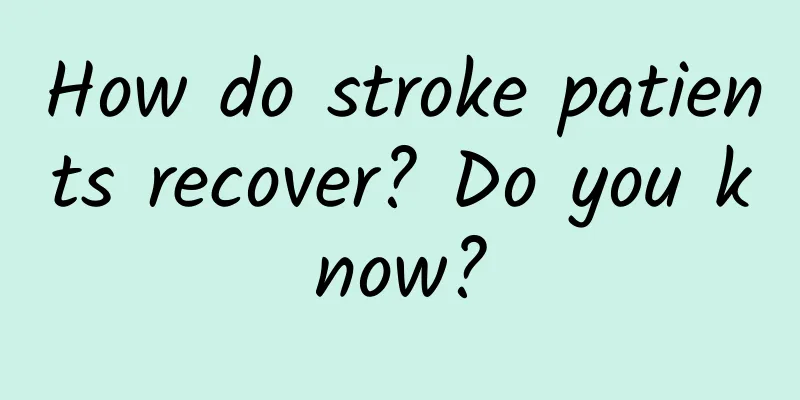How do stroke patients recover? Do you know?

|
Stroke has a high incidence, mortality and disability rate. Correct and scientific rehabilitation, treatment and prevention work for patients in the early stage can effectively reduce patients' functional impairment, improve their daily quality, enhance their ability to take care of themselves, and shorten their hospital stay. So, do you know how to rehabilitate stroke patients? This article will give you a brief introduction. 1. What is a stroke? "Stroke" is also called "apoplexy" and "cerebrovascular accident". It is an acute cerebrovascular disease, mainly due to the sudden rupture or blockage of blood vessels in the brain, which prevents blood from flowing into the brain, leading to brain tissue damage such as ischemic and hemorrhagic stroke. Occlusion or stenosis of the internal carotid artery and vertebral artery is the main cause of ischemic stroke. Hemorrhagic stroke has a high mortality rate. Stroke is characterized by high morbidity, high mortality and high disability rate.
2. Causes of stroke 2.1 Vascular risk factors The most common cause of stroke is the presence of small emboli in the brain, which break off from blood vessels and cause artery-to-artery embolism, also known as ischemic stroke. Atherosclerosis is an important cause of stenosis and occlusion of the internal carotid artery and vertebral artery. 2.2 Gender, age, race, etc. Compared with other countries, the incidence of stroke in my country is significantly higher than that of heart disease. 2.3 Bad living habits Most of them have multiple risk factors, such as smoking, unhealthy eating habits, obesity, lack of exercise, heavy drinking, and high homocysteine, etc. It may also be due to underlying diseases such as high blood pressure, diabetes, and hyperlipidemia. These factors can lead to the risk of stroke.
3. Rehabilitation treatment for stroke patients Early rehabilitation treatment of stroke has not received enough attention in my country, especially the psychological, behavioral, intellectual and language disorders, as well as functional impairment and cognitive impairment of stroke patients. Early and standardized stroke rehabilitation is of great significance to improving labor capacity and quality of life. After systematic rehabilitation treatment, about 60% of stroke patients can live a normal life, and 30% of patients can return to work in the first year.
For patients with acute stroke, rehabilitation treatment should be carried out as soon as possible after the condition stabilizes. For patients with mild to moderate stroke, bedside rehabilitation and early rehabilitation training out of bed can be started 24 hours after onset when vital signs are stable and there is no obvious progression of the condition. Three months after a stroke is the golden period for rehabilitation treatment, and the earlier the rehabilitation treatment is carried out, the better. Timely, safe, scientific, and standardized rehabilitation training and treatment can effectively reduce the mortality and disability rates of stroke patients. Therefore, for stroke patients, in addition to conventional drug treatment, early rehabilitation treatment should also be carried out. Only by fully understanding the conditions for early rehabilitation of stroke and closely monitoring risk factors can the prognosis of patients be improved, thereby improving the quality of life of patients, reducing hospitalization time, and reducing the economic burden of patients. For the rehabilitation treatment of stroke patients, the main treatment methods include upper limb force feedback motor control training system, multi-joint isokinetic muscle strength testing and training system, repeated transcranial magnetic stimulation, mirror therapy, transcranial direct current and shock wave, etc., which can effectively intervene in some sequelae of stroke. 3.1 Motor function rehabilitation training activities Motor dysfunction is an important factor affecting patients' ability to live in daily life, which can be treated as follows: 3.1.1 Facilitated conduction technology: Utilize different neurophysiological reflex principles to achieve the purpose of promoting muscle contraction and relieving muscle spasms. 3.1.2 Physical therapy: Use a variety of physical factors such as light, electricity, heat, cold, water, and machinery to promote the patient's cerebral blood circulation, promote body muscle contraction, reduce muscle tension, and relieve muscle spasms and contractures. 3.1.3 Medical exercise: muscle strength training, including passive exercise, active exercise, assisted exercise and resistance exercise; balance and walking training, including sitting balance training, gradually transitioning from assisted and self-support to independent standing, and then practicing balance, assisted walking, etc.; medical gymnastics, etc. 3.1.4 Training in daily living activities: After the limb muscle strength has recovered to a certain extent, try to carry out daily living activities, such as dressing and undressing, urinating, defecating, feeding oneself, etc. 3.1.5 Occupational therapy: After reaching a certain level of medical exercise, planned, purposeful, targeted, practical, safe, scientific and standardized activity training will be started, such as sewing clothes, practicing embroidery, painting, writing calligraphy, playing chess, playing cards, and table tennis, etc.
3.2 Swallowing rehabilitation training activities Bulb palsy or pseudobulbar palsy is a manifestation of stroke, mainly manifested as swallowing disorders, dysarthria, etc. Patients often aggravate stroke or even die due to swallowing errors and respiratory infections. When stroke patients have swallowing disorders, they need to strictly control their diet and cannot eat. Instead, they need intravenous rehydration to supplement nutrition. If the swallowing function is not restored, they need nasogastric feeding. After the condition stabilizes, swallowing function rehabilitation training should be performed. First, neck activity training, perioral and tongue muscle exercise training, cheek puffing and facial massage should be performed. At the same time, breathing training and coughing training should also be performed. According to the above training, when there is a certain training effect, direct swallowing training can be performed. It should be noted that the oropharyngeal cavity should be kept clean before proceeding. Ice cubes can be used to stimulate the oral cavity, tongue root, pharynx and other parts to enhance the reflex function of the swallowing muscles. During swallowing training, the patient sits with the neck slightly tilted forward to enhance the function of the swallowing muscles. For patients with damaged vagus nerve, when swallowing, they can turn their head to the paralyzed side to shrink the paralyzed side of the pharyngeal cavity and expand the esophageal opening on the healthy side to facilitate the passage of food bolus from the esophageal opening and avoid food residue in the pyriform sinus. Before each swallowing, you should take enough air, hold your breath consciously, close your throat, and cough lightly after swallowing to keep the respiratory tract clean.
In the early stage of eating, you should choose food with appropriate viscosity, paste and flavor that is not easy to loosen, and do not eat food with scattered rice grains. After the swallowing function is improved, you can eat liquid food and slowly resume normal diet. When training the swallowing function, you must keep the oropharynx clean. You must clean the oropharynx before and after eating. If you have a respiratory infection, you should suspend the swallowing function training. 3.3 Speech function rehabilitation training Language disorders, such as aphasia and dysarthria, are common clinical symptoms and signs in stroke patients. 3.3.1 Conduct Schuell stimulation training: Through multi-channel speech stimulation such as auditory stimulation, that is, multiple stimulations such as vision, touch, and smell are carried out simultaneously to maximize the recovery and remodeling of language functions, including listening, speaking, reading, and writing. 3.3.2 Cognitive, memory and thinking stimulation methods, mainly targeting patients’ semantic cognition experiments, semantic memory experiments, semantic thinking experiments, etc.; 3.3.3 Mouth shape, pronunciation, lips and tongue functions training; 3.3.4 Training of gesture communication; 3.3.5 Reading and writing training; 3.3.6 Rehabilitation training for articulation disorders mainly includes: tongue, lip, jaw movement function, nasopharyngeal function training and breathing pronunciation training. 3.4 Rehabilitation training for psychological disorders and emotional cognition On the basis of rehabilitation training for patients with cognitive and psychological disorders, motor and language function training is combined. Let patients watch real objects, talk about the content of pictures, or talk to patients after watching TV, so that patients can have a deeper understanding and recall of the content, thereby promoting their cognitive and memory recovery. Stroke patients are mainly characterized by emotional disorders, anxiety, and depression. In addition to drug treatment, psychotherapy can be used to explain to patients the nature of the disease and the difficult process of restoring normal functions. In rehabilitation training, they should cooperate with doctors to restore their neurological functions faster. 4. Conclusion For stroke patients, the earlier the rehabilitation intervention, the more effective it is to reduce the occurrence of complications and the better the functional recovery after recovery. |
<<: Summer heat stroke safety guide
Recommend
What are the benefits of eating garlic? Benefits of eating garlic for women
Garlic has very good anti-inflammatory and bacter...
When will the heavy snow begin in 2021? When will the heavy snow begin in 2021?
The Big Snow solar term is the 21st solar term in...
Women must read: Recommended powerful blood-enriching foods
Qi and blood are very important for a woman. Whet...
Methods and foods to nourish the stomach, six foods you must eat to nourish the stomach
Stomach health is of great significance to human ...
Can a child's height be predicted? Is there any way to make the child grow taller?
We often say that the height of adults will affec...
How to clean the vagina correctly
The vagina is a relatively private part of women....
Can I take 2 tablets of ibuprofen for dysmenorrhea?
Ibuprofen Ibuprofen capsules are milky white sphe...
How many prenatal checkups should you do during pregnancy
The standard prenatal check-up after pregnancy sh...
I drank a lot of saffron when I was pregnant.
You cannot drink saffron when you are just pregna...
What are the causes of back pain in girls?
Generally speaking, the reasons for low back pain...
What medicine should I take if there is a lot of leucorrhea with a strange smell?
It is abnormal if there is a lot of leucorrhea wi...
How to treat breast hyperplasia best? Chinese medicine remedies
Breasts are important organs of the female body. ...
The best way to detoxify your ovaries
The ovaries are important reproductive organs for...
Is postpartum pelvic floor repair necessary?
It is very necessary for women to perform pelvic ...
Where is the uterus located? Pictures of where is the uterus located?
The uterus point is located in the lower abdomen....









